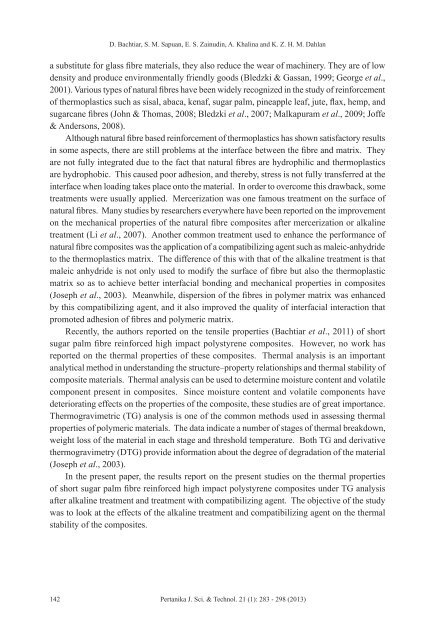JST Vol. 21 (1) Jan. 2013 - Pertanika Journal - Universiti Putra ...
JST Vol. 21 (1) Jan. 2013 - Pertanika Journal - Universiti Putra ...
JST Vol. 21 (1) Jan. 2013 - Pertanika Journal - Universiti Putra ...
Create successful ePaper yourself
Turn your PDF publications into a flip-book with our unique Google optimized e-Paper software.
D. Bachtiar, S. M. Sapuan, E. S. Zainudin, A. Khalina and K. Z. H. M. Dahlan<br />
a substitute for glass fibre materials, they also reduce the wear of machinery. They are of low<br />
density and produce environmentally friendly goods (Bledzki & Gassan, 1999; George et al.,<br />
2001). Various types of natural fibres have been widely recognized in the study of reinforcement<br />
of thermoplastics such as sisal, abaca, kenaf, sugar palm, pineapple leaf, jute, flax, hemp, and<br />
sugarcane fibres (John & Thomas, 2008; Bledzki et al., 2007; Malkapuram et al., 2009; Joffe<br />
& Andersons, 2008).<br />
Although natural fibre based reinforcement of thermoplastics has shown satisfactory results<br />
in some aspects, there are still problems at the interface between the fibre and matrix. They<br />
are not fully integrated due to the fact that natural fibres are hydrophilic and thermoplastics<br />
are hydrophobic. This caused poor adhesion, and thereby, stress is not fully transferred at the<br />
interface when loading takes place onto the material. In order to overcome this drawback, some<br />
treatments were usually applied. Mercerization was one famous treatment on the surface of<br />
natural fibres. Many studies by researchers everywhere have been reported on the improvement<br />
on the mechanical properties of the natural fibre composites after mercerization or alkaline<br />
treatment (Li et al., 2007). Another common treatment used to enhance the performance of<br />
natural fibre composites was the application of a compatibilizing agent such as maleic-anhydride<br />
to the thermoplastics matrix. The difference of this with that of the alkaline treatment is that<br />
maleic anhydride is not only used to modify the surface of fibre but also the thermoplastic<br />
matrix so as to achieve better interfacial bonding and mechanical properties in composites<br />
(Joseph et al., 2003). Meanwhile, dispersion of the fibres in polymer matrix was enhanced<br />
by this compatibilizing agent, and it also improved the quality of interfacial interaction that<br />
promoted adhesion of fibres and polymeric matrix.<br />
Recently, the authors reported on the tensile properties (Bachtiar et al., 2011) of short<br />
sugar palm fibre reinforced high impact polystyrene composites. However, no work has<br />
reported on the thermal properties of these composites. Thermal analysis is an important<br />
analytical method in understanding the structure–property relationships and thermal stability of<br />
composite materials. Thermal analysis can be used to determine moisture content and volatile<br />
component present in composites. Since moisture content and volatile components have<br />
deteriorating effects on the properties of the composite, these studies are of great importance.<br />
Thermogravimetric (TG) analysis is one of the common methods used in assessing thermal<br />
properties of polymeric materials. The data indicate a number of stages of thermal breakdown,<br />
weight loss of the material in each stage and threshold temperature. Both TG and derivative<br />
thermogravimetry (DTG) provide information about the degree of degradation of the material<br />
(Joseph et al., 2003).<br />
In the present paper, the results report on the present studies on the thermal properties<br />
of short sugar palm fibre reinforced high impact polystyrene composites under TG analysis<br />
after alkaline treatment and treatment with compatibilizing agent. The objective of the study<br />
was to look at the effects of the alkaline treatment and compatibilizing agent on the thermal<br />
stability of the composites.<br />
142 <strong>Pertanika</strong> J. Sci. & Technol. <strong>21</strong> (1): 283 - 298 (<strong>2013</strong>)





